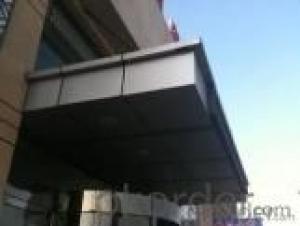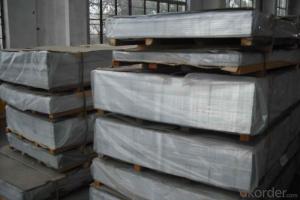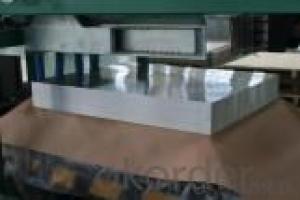Mill Finished Aluminum Coil for Aluminum Composite Panel
- Loading Port:
- Shanghai
- Payment Terms:
- TT OR LC
- Min Order Qty:
- 1 m.t.
- Supply Capability:
- 2000 m.t./month
OKorder Service Pledge
OKorder Financial Service
You Might Also Like
Item specifice
Structure of Prepainted Aluminium Coil PPGL Description:
1)Alloy: 1050,1060, 1100,1235,etc.
2)Temper:O, H12,H16, H18,H22,H24, H26 etc.
3)Surface treatment:polished,anodized,mill finishing
4) Material available: 1050,1060,1235,3003,3004, 3105, 3A21,5052,5083, 5754, 5A05, 6061, 8011etc.
Main Features of Aluminium Coil PPGL:
Mainly in Construction, decoration, PCB materials, cover material, LCD back panel, refrigeration, air conditioner, automobile, etc
Images of Aluminium Coil PPGL:
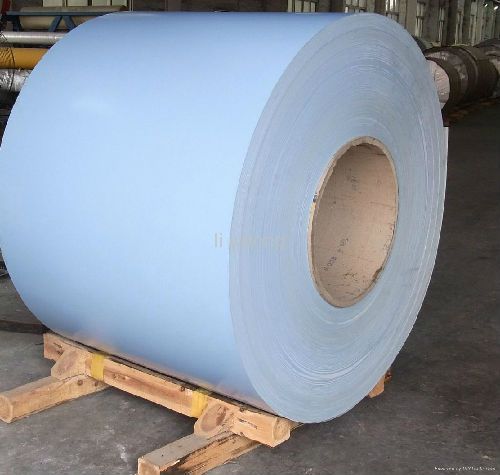
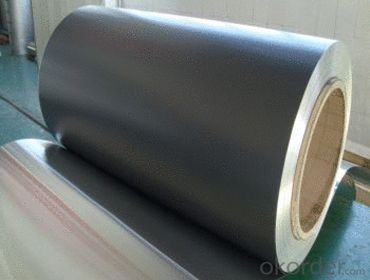
Aluminium Coil PPGL Specification:
Product Name | Aluminum Coil |
Alloy | A1100,A3003,A1050,A8011,A3105,A5005 etc |
Thickness | 0.022mm to 3.0 mm |
Width | Standard width:1240mm; 1200mm |
All width: 30mm - 1600mm | |
Diameter | out dia:1200mm |
Interior dia: 405mm,505mm | |
Weight | 2.5 T/coil,3.0 T/coil |
Coating | PE,PVDF,ACRYLIC |
Surface | Embossed, mill finish, coated; aluminum gutter coil |
Color | AS to all RAL color |
Gloss | 10-90%(EN ISO-2813:1994) |
Coating Thickness | PE: more than 18 micron |
PVDF: more than 25 micron | |
Coating Hardness (pencil resistance) | More than 2h |
Coating adhesion | 5J(EN ISO-2409:1994) |
Impact Resistance | No peeling or cracking(50 kg/cm,ASTMD-2794:1993) |
Flexibility (T-bend) | 2T |
MEK resistance | More than 100 |
Characteristic:
1) High gloss
2) High flexibility
3) Impact resistance
4) Excellent weather-proof durability
5) Anti-ultraviolet
6) High erosion resistance
7) Stable color and gloss
8) Good mechanical processing performance
9) Abrasion resistance
Applications:
1) Raw materials of aluminum ceiling, aluminum composite panel, aluminum sheet.
2)Mterials of aluminum signs, advertisement board
3) Roofs, wall cladding.
4) Package materials, flip off seals
FAQ of Aluminium Coil PPGL:
1.Superior quality of raw material.
2.Reasonable and stable chemical composition.
3.Accurate tolerance.
4.Goode mechanical property.
5.We have the certificate of ISO9001.
- Q:What are aluminum sheets made of?
- Pure aluminum or aluminum alloy is typically used to make aluminum sheets. Aluminum alloy is a mixture of aluminum and other elements like copper, magnesium, or zinc. The composition of the alloy varies depending on the intended use and desired properties of the sheet. Pure aluminum sheets are softer and easier to shape, while alloyed aluminum sheets provide greater strength, durability, and resistance to corrosion. To produce the sheets, a rolling process is employed, where a large block or ingot of aluminum is passed through rollers to decrease its thickness and form the desired size of the sheet.
- Q:How does the surface treatment affect the corrosion resistance of aluminum sheet?
- The surface treatment of aluminum sheet plays a significant role in enhancing its corrosion resistance. Aluminum is inherently corrosion-resistant due to the formation of a thin oxide layer on its surface. However, this oxide layer is not always sufficient to protect the metal from aggressive environments or harsh conditions. Surface treatments such as anodizing, chromating, or painting can provide an additional protective layer on the aluminum sheet, significantly improving its corrosion resistance. Anodizing involves creating a controlled oxide layer on the surface of the aluminum through an electrochemical process. This layer is highly resistant to corrosion, offering excellent protection against various corrosive agents. Chromating, on the other hand, involves the application of a chromate conversion coating, which forms a thin film on the aluminum surface. This coating acts as a barrier, preventing corrosive substances from reaching the metal and causing oxidation. It also enhances the adhesion of subsequent paint or adhesive layers. Painting is another commonly used surface treatment for aluminum sheets. The application of a paint layer not only protects the metal from corrosion but also provides an aesthetic finish. The paint acts as a physical barrier that shields the aluminum from moisture, chemicals, and other corrosive elements. The choice of surface treatment depends on the specific application and the level of corrosion resistance required. Anodizing is often preferred for aluminum sheets used in construction, automotive, and aerospace industries, as it provides excellent corrosion protection and improves the appearance of the metal. Chromating is commonly used in electrical and electronic applications, as it offers both corrosion resistance and electrical conductivity. Painting is suitable for applications where aesthetics and corrosion protection are equally important, such as architectural elements or consumer products. In conclusion, the surface treatment of aluminum sheet significantly affects its corrosion resistance. Anodizing, chromating, and painting all contribute to enhancing the protective properties of aluminum against corrosion, thereby extending its lifespan and ensuring its durability in various environments.
- Q:Can aluminum plates be welded with stainless steel or iron nuts?
- Upstairs is quite right! Even with brazing, it's hard to operate without experience
- Q:Can 101 aluminum sheets be used in aerospace applications?
- Yes, 101 aluminum sheets can be used in aerospace applications. 101 aluminum is a commonly used alloy in the aerospace industry due to its excellent strength-to-weight ratio, high corrosion resistance, and good formability. It is often used for structural components, such as aircraft skins, wings, and fuselage panels. Additionally, 101 aluminum sheets can be easily machined and welded, making them ideal for aerospace applications where precision and durability are crucial.
- Q:Can 101 aluminum sheets be bonded to other materials?
- Yes, 101 aluminum sheets can be bonded to other materials. Aluminum can be bonded using various methods such as adhesive bonding, welding, or mechanical fastening techniques. The choice of bonding method depends on the specific materials being bonded and the desired strength and durability of the bond.
- Q:When Aluminium nitrate is heated , i got yellow amorphous solid which did not not melt on further heating. What compound is that?
- l would say you have mostly aluminum oxide as a product which probably contains some Nitrogen dioxide gas, a second product of the decomposition of aluminum nitrate. If I were you I would not heat nitrate salts as they can explode upon heating. they also need to be kept away from any kind of reducing agent such as powdered metals, or any fuels, reactions can be violent.
- Q:What is the electrical resistivity of aluminum sheets?
- The electrical resistivity of aluminum sheets typically ranges from 2.65 to 2.82 micro-ohm centimeters. However, it is important to note that the exact resistivity can vary depending on the specific alloy composition, thickness, temperature, and other factors.
- Q:Are the aluminum sheets suitable for manufacturing architectural ceiling panels?
- Yes, aluminum sheets are suitable for manufacturing architectural ceiling panels. Aluminum is known for its durability, lightweight nature, and resistance to corrosion, making it an ideal material for architectural applications. It can be easily shaped and formed into various panel designs and sizes, offering flexibility in creating unique ceiling designs. Additionally, aluminum sheets are available in different finishes and colors, allowing for customization to meet specific design requirements. Overall, aluminum sheets provide a cost-effective and aesthetically pleasing solution for manufacturing architectural ceiling panels.
- Q:What are the different surface finishes available for aluminum sheets?
- Aluminum sheets offer a variety of surface finishes, each with its own unique qualities and aesthetic appeal. Some commonly used finishes include: 1. Mill Finish: This is the most basic finish achieved by leaving the aluminum in its as-rolled state, without any further treatment. It has a smooth and shiny appearance, but may have slight imperfections and is not as durable as other finishes. 2. Anodized Finish: Anodizing is an electrochemical process that creates a protective layer on the surface of the aluminum sheet. This finish enhances corrosion resistance, improves durability, and offers a wide range of color options. Anodized finishes can be matte or glossy. 3. Brushed Finish: By brushing the aluminum sheet with a fine abrasive material, a textured pattern is created. This finish is commonly used for decorative purposes and provides a unique and attractive appearance. 4. Polished Finish: Polishing the aluminum sheet using abrasive materials creates a smooth and reflective surface. This finish is often used for decorative purposes, giving the aluminum a high-end, mirror-like appearance. 5. Embossed Finish: Embossing involves creating raised or recessed patterns on the surface of the aluminum sheet. This finish is commonly used for decorative purposes, adding texture and visual interest to the material. 6. Powder Coated Finish: Powder coating entails applying a dry powder to the aluminum sheet and curing it under heat. This finish provides a durable and weather-resistant coating, available in a wide range of colors and textures. 7. Patterned Finish: Patterned finishes are achieved by imprinting various designs or patterns onto the surface of the aluminum sheet. This finish is often used in architectural applications, adding visual interest to the material. These examples demonstrate the range of surface finishes available for aluminum sheets. The choice of finish depends on the desired appearance, functionality, and application requirements.
- Q:Are aluminum sheets suitable for automotive body panels?
- Yes, aluminum sheets are suitable for automotive body panels for several reasons. Firstly, aluminum is a lightweight material, which helps improve fuel efficiency and overall vehicle performance. This can result in better acceleration, handling, and braking. Additionally, the use of aluminum body panels can contribute to reducing the overall weight of the vehicle, which is particularly important for electric vehicles, as it can extend their range. Secondly, aluminum has excellent corrosion resistance properties. It naturally forms a protective oxide layer on its surface, which helps prevent rusting and deterioration caused by exposure to various weather conditions. This makes aluminum sheets highly durable and long-lasting, ensuring that automotive body panels maintain their structural integrity over time. Furthermore, aluminum is highly malleable and can be easily formed into complex shapes using various manufacturing techniques such as stamping, extrusion, and hydroforming. This allows for greater design flexibility, enabling automakers to create vehicles with sleek and aerodynamic body styles. Additionally, aluminum can be easily joined through welding or adhesive bonding, making it easier to assemble and repair automotive body panels. Moreover, aluminum is a sustainable material as it is highly recyclable. Recycling aluminum requires significantly less energy compared to primary production, resulting in reduced greenhouse gas emissions. This aligns with the growing emphasis on sustainability and environmental consciousness in the automotive industry. Overall, the use of aluminum sheets in automotive body panels offers numerous advantages such as improved fuel efficiency, corrosion resistance, design flexibility, and sustainability. These factors make aluminum a suitable and increasingly popular choice for automakers aiming to enhance the performance, durability, and environmental friendliness of their vehicles.
1. Manufacturer Overview |
|
|---|---|
| Location | |
| Year Established | |
| Annual Output Value | |
| Main Markets | |
| Company Certifications | |
2. Manufacturer Certificates |
|
|---|---|
| a) Certification Name | |
| Range | |
| Reference | |
| Validity Period | |
3. Manufacturer Capability |
|
|---|---|
| a)Trade Capacity | |
| Nearest Port | |
| Export Percentage | |
| No.of Employees in Trade Department | |
| Language Spoken: | |
| b)Factory Information | |
| Factory Size: | |
| No. of Production Lines | |
| Contract Manufacturing | |
| Product Price Range | |
Send your message to us
Mill Finished Aluminum Coil for Aluminum Composite Panel
- Loading Port:
- Shanghai
- Payment Terms:
- TT OR LC
- Min Order Qty:
- 1 m.t.
- Supply Capability:
- 2000 m.t./month
OKorder Service Pledge
OKorder Financial Service
Similar products
New products
Hot products
Related keywords

